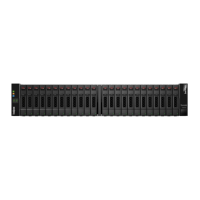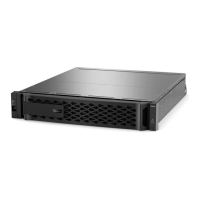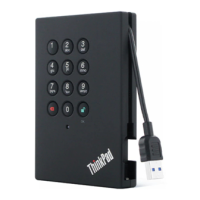Format the LUN with a file system such as ext4. Some applications do not require this step.
Step 1. Retrieve the SCSI ID of the mapped disk by issuing the ssaannlluunn lluunn sshhooww --pp command.The SCSI ID
is a 33-character string of hexadecimal digits, beginning with the number 3. If user-friendly names
are enabled, Device Mapper reports disks as mpath instead of by a SCSI ID.
# sanlun lun show -p
DE-Series Array: ictm1619s01c01-SRP(60080e50002908b40000000054efb9d2)
Volume Name:
Preferred Owner: Controller in Slot B
Current Owner: Controller in Slot B
Mode: RDAC (Active/Active)
UTM LUN: None
LUN: 116
LUN Size:
Product: DE-Series
Host Device: mpathr(360080e50004300ac000007575568851d)
Multipath Policy: round-robin 0
Multipath Provider: Native
--------- ---------- ------- ------------ ----------------------------------------------
host controller controller
path path /dev/ host target
state type node adapter port
--------- ---------- ------- ------------ ----------------------------------------------
up secondary sdcx host14 A1
up secondary sdat host10 A2
up secondary sdbv host13 B1
Step 2. Create a new partition according to the method appropriate for your Linux OS release. Typically,
characters identifying the partition of a disk are appended to the SCSI ID (the number 1 or p3 for
instance).
# parted -a optimal -s -- /dev/mapper/360080e5000321bb8000092b1535f887a mklabel
gpt mkpart primary ext4 0% 100%
Step 3. Create a file system on the partition.The method for creating a file system varies depending on the
file system chosen.
# mkfs.ext4 /dev/mapper/360080e5000321bb8000092b1535f887a1
Step 4. Create a folder to mount the new partition.
# mkdir /mnt/ext4
Step 5. Mount the partition.
# mount /dev/mapper/360080e5000321bb8000092b1535f887a1 /mnt/ext4
Verify storage access on the host
Before using the volume, you verify that the host can write data to the volume and read it back.
Before you begin
You must have initialized the volume and formatted it with a file system.
Step 1. On the host, copy one or more files to the mount point of the disk.
Step 2. Copy the files back to a different folder on the original disk.
Step 3. Run the ddiiffff command to compare the copied files to the originals.
Remove the file and folder that you copied.
Chapter 2. System setup and configuration 77

